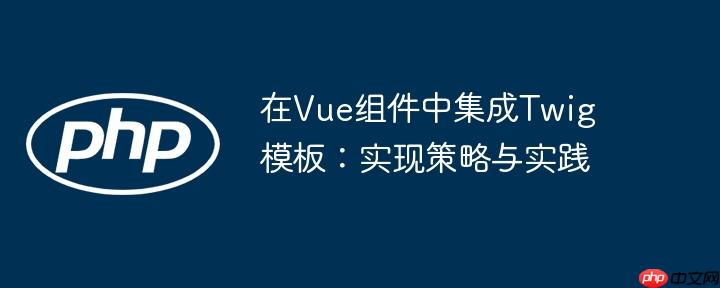
在现代web开发中,vue.js作为前端框架提供了强大的交互能力和组件化开发模式,而twig作为流行的php模板引擎,则在后端渲染静态或动态html方面表现出色。开发者有时会面临一个常见需求:如何在vue组件内部复用或集成已有的twig模板。然而,直接在vue组件的模板语法中嵌入twig模板代码(例如{% block field %})是不可行的,因为twig模板需要在服务器端由php解释器进行渲染,而vue组件则在浏览器端进行编译和渲染。本文将详细介绍两种可行的替代方案及其应用场景。
最直接且推荐的方法是完全放弃在Vue组件中直接使用Twig模板,而是将Twig模板中负责渲染UI的逻辑和数据展示完全转换成Vue组件的代码。这意味着你需要用Vue的模板语法(例如v-for、v-if、{{ data }})来重新构建原有的HTML结构和数据绑定。
实现思路:
分析Twig模板结构: 仔细审查你的Twig模板(如plan.html.twig),识别其中用于展示数据、循环列表或条件渲染的部分。
{# plan.html.twig 示例 #}
{% block field %}
<table id="plan_table">
<caption>
<h2> {{smth.name}} </h2>
</caption>
<tbody>
{% for item in smth.items %}
<tr>
<td>{{ item.id }}</td>
<td>{{ item.description }}</td>
</tr>
{% endfor %}
</tbody>
</table>
{% endblock %}Vue组件重构: 在Vue组件(如Plan.vue)中,使用Vue的模板语法和组件逻辑来复现相同的功能。数据通常通过props从父组件传递,或者在组件内部通过API请求获取。
立即学习“前端免费学习笔记(深入)”;
<!-- Plan.vue 示例 -->
<template>
<div class="plan__content">
<table id="plan_table">
<caption>
<h2> {{ planData.name }} </h2>
</caption>
<tbody>
<tr v-for="item in planData.items" :key="item.id">
<td>{{ item.id }}</td>
<td>{{ item.description }}</td>
</tr>
</tbody>
</table>
</div>
</template>
<script>
export default {
name: 'Plan',
props: {
// 假设数据通过props传递,或者在created/mounted钩子中获取
planData: {
type: Object,
required: true
}
},
// ... 其他组件逻辑,如关闭模态框事件等
}
</script>数据传递: 确保将后端提供的数据(原来用于填充Twig模板的数据)正确地传递给Vue组件。
优点:
缺点:
当Twig模板包含复杂或难以在Vue中重构的逻辑,或者您希望最大化地复用现有后端渲染的HTML时,此方法非常适用。其核心思想是让后端服务器渲染Twig模板,然后Vue组件通过HTTP请求获取这段已渲染的HTML字符串,并将其动态插入到DOM中。
实现思路:
后端暴露API接口: 后端需要提供一个API端点,该端点负责接收请求,使用Twig模板引擎渲染指定的Twig文件,并将生成的HTML作为响应返回。
// Symfony/Laravel 伪代码示例
// Route: /api/render-plan-html
public function renderPlanHtml(Request $request)
{
$data = $this->getDataForPlan(); // 获取Twig模板所需数据
$html = $this->twig->render('plan.html.twig', ['smth' => $data]);
return new Response($html, 200, ['Content-Type' => 'text/html']);
}Vue组件发起HTTP请求: 在Vue组件中,当需要显示Twig模板内容时,发起一个异步HTTP请求到上述后端API端点。
使用v-html指令渲染: 将获取到的HTML字符串赋值给组件的数据属性,然后使用Vue的v-html指令将这段HTML插入到DOM中。
<!-- Plan.vue 示例 -->
<template>
<div class="plan__content">
<div v-if="isLoading">加载中...</div>
<div v-else v-html="renderedTwigContent"></div>
</div>
</template>
<script>
import axios from 'axios'; // 或使用其他HTTP客户端
export default {
name: 'Plan',
data() {
return {
renderedTwigContent: '',
isLoading: false
};
},
mounted() {
this.fetchTwigContent();
},
methods: {
async fetchTwigContent() {
this.isLoading = true;
try {
const response = await axios.get('/api/render-plan-html'); // 替换为你的API地址
this.renderedTwigContent = response.data;
} catch (error) {
console.error('获取Twig内容失败:', error);
this.renderedTwigContent = '<p style="color: red;">内容加载失败。</p>';
} finally {
this.isLoading = false;
}
},
// ... 其他组件逻辑
}
}
</script>在父组件Example.vue中,你就可以这样使用Plan组件:
<!-- Example.vue 示例 -->
<template>
<div>
<button @click="showPlan">Show plan</button>
<plan v-if="isPlanVisible" @closePlan="closePlan"></plan>
</div>
</template>优点:
缺点与注意事项:
在Vue组件中集成Twig模板,核心在于理解前后端渲染机制的差异。直接嵌入是不可行的。开发者应根据项目需求和现有代码库选择最合适的策略:
无论选择哪种方法,清晰地分离前后端职责,确保数据流的顺畅,并时刻关注代码的可维护性和安全性,是构建健壮Web应用的关键。
以上就是在Vue组件中集成Twig模板:实现策略与实践的详细内容,更多请关注php中文网其它相关文章!

每个人都需要一台速度更快、更稳定的 PC。随着时间的推移,垃圾文件、旧注册表数据和不必要的后台进程会占用资源并降低性能。幸运的是,许多工具可以让 Windows 保持平稳运行。

Copyright 2014-2025 https://www.php.cn/ All Rights Reserved | php.cn | 湘ICP备2023035733号